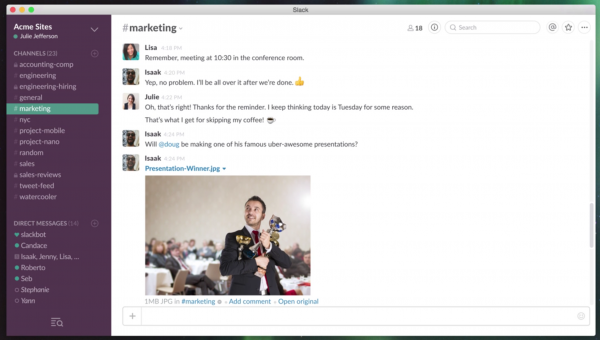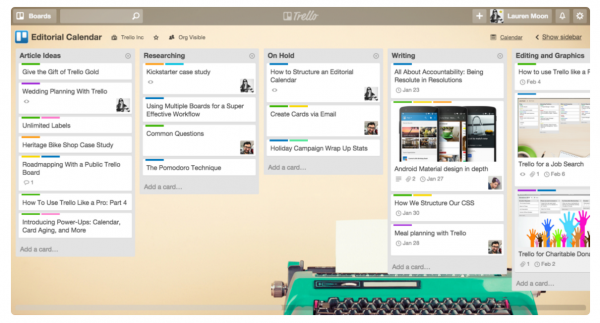Create digital magazine teams using agile principles and progressive technology to build more collaborative processes

Magazine teams have historically all been in one building, maybe in New York City, or Washington, D.C. They might occupy more than 20 floors in the World Trade Center, like Condé Nast, or a more humble space, like many of the niche publishers we know. But as teams are growing into more remote directions, due to talent seeking, cost savings, and tech availability, there’s more of a need for cloud-based collaboration tools, communication tools, and accountability tools.
More and more in an industry that’s more often regarded as the “get off my lawn” type, resistant to change, but eager to advance, I’m seeing teams work rather effectively with a suite of new tools available at affordable and scalable costs for small and large teams.
[text_ad]
Slack, for example, has taken the startup scene by storm due to it’s incredible ability to make a remote team feel like they’re all in the same room together. It’s a tool that creates a private chat room specifically for your organization. You can create “channels” which you invite specific team members to, so you can discuss specific projects. You can also have private conversations with all of your colleagues. It’s especially useful for sharing files, getting instant feedback, seeing when your colleagues are online, and has pop-up notifications on your desktop and mobile device you can turn on or off, to get notifications just for you, or all that come through. This tool is completely free, and the only downside is that you only get 10k worth of messages in your searchable history. If you want to find a conversation you had, or a file from last year, the paid plan costs just $7 per user.
In terms of updating content production for publishers, you’re starting to see them taking on the processes and frameworks from the development community. For example, GitHub is a repository of code, and a bit of a social network for programmers. Ultimately it’s a place to share code with other programmers. And more importantly, it’s repository for your company’s code, that can easily be shared, updated and tracked throughout the organization.
Major publications like The New York Times, Quartz and The Atlantic all have GitHub accounts where they share snippets of code other programmers might find useful (and code your own developers will very likely find useful). I’m sure they also have code they only share privately within their organization through GitHub, but there’s plenty to sift through available for free.
In fact, the New York Times newsroom has their own Github page, with an Adobe Illustrator script for turning graphics into html. Here’s how it was used pretty incredibly on their site:
The Agile Method, which refers to a process of software development that focuses on project management in sprints. Sprints are the time period set aside for the phase of a project. When the sprint is over, the phase is over, and all work ceases while the next sprint begins. Agile Development stands on the principles of a hugely collaborative work environment where everyone is pitching in at the same time, with equal say in a project, where no ones job is more important than the other, with one main goal in mind, like customer satisfaction, but it also demands a maintainable pace for everyone involved, which is why the sprint deadline is so strict.
In development of content, we’re already seeing magazine teams in this sprint mode of agile content development. There are only hard deadlines for digital content, and in fact maybe the Agile Method was based on a publisher’s need to hit a newsstand date each and every month. But for obvious reasons, it’s the software developers who have come up with progressive systems and actual software to make this process less stressful and more collaborative.
Slack is one of the most popular tools, and GitHub is another. But there are many more tools that Agile developers are using that you can adopt into your own organization, if you’re moving into a more collaborative zone, especially if your remote team is growing.
Basecamp is not exactly a new tool, but if you understand the premise of this basic project management tool that is common in software development circles, then imagine it for content teams, and call it Asana. Asana is much better suited for content teams, simply by look and feel which resembles the look of a common content management system. You can create tasks, and subtasks. So for example, you can create a task for yourself, like writing an article on how to prune your rose bush. Then you can have several other stages, like graphic design to create images for the article, social media for someone to write the social for the post, and a stage for editing. As each person completes a task, they assign it to the next person in line. It can be a great tool for tracking stages of a project visually.
There’s no reason to create documents that can’t be shared and edited by multiple people anymore. Even Microsoft Word is collaborative these days with Microsoft 2016 and Microsoft OneDrive. However if you’re looking for a great way to organize all types of content, you could create a folder in Google Drive. My recommendation is to create a workable structure and some guidelines before letting people loose in here. Identify how they should title their files, which folders they should use, what they should keep in there, and which they should not, who should have permissions, and who should not. And with regularity, update permissions.
Dropbox is a similar solution that has been touted as being more secure, but you have the bonus advantage of using it to keep your entire hard drive backed up. You can create folders that are only shared with specific team members, or with the whole organization. You can store content within these folders just like they would be on your desktop, and edit files which will update for everyone else who is connected to that dropbox. The luxury of this is that you can keep any type of file you need in these folders, like InDesign or Photoshop files.
Speaking of Adobe products, they are all hosted on the cloud now. I know you’ve paid thousands of dollars in single-user Adobe software that’s been downloaded to computers, but take the discounted upgrade and move to the cloud. It means your team will be able to share assets, feedback, and reports in one central location. There’s Adobe Marketing Cloud which is more geared toward asset management, and also Creative Cloud for Teams which is geared toward collaboration.
Trello is another popular tool for collaborative teams. It’s a very visual task-management cloud-based software that almost reminds you of sticky notes (although it’s much better looking than that.) But if you’ve ever been the type to organize your to-dos by a wall of organized sticky notes, this interface will seem very familiar to you. Except that you can assign tasks to people, apply deadlines, and embed graphics and files into them. It integrates with other apps above like Github, Slack, Dropbox, Google Drive and Salesforce. While Trello can be used for task management, companies have also found ways to use is as an employee directory / onboarding tool, recruiting and hiring, and an IT support system. Here’s some tips on how to use Trello as an editorial management tool.
OK now it’s your turn. I’ve only scratched the surface here, so I’d love to know what collaborative tools your digital magazine teams are using. Leave a comment below with your suggestions and how you’re using them.






